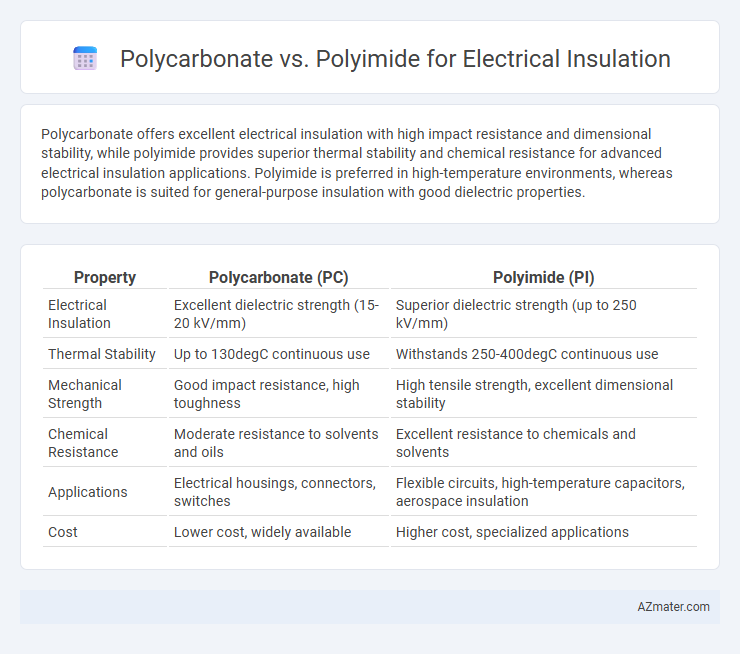Polycarbonate offers excellent electrical insulation with high impact resistance and dimensional stability, while polyimide provides superior thermal stability and chemical resistance for advanced electrical insulation applications. Polyimide is preferred in high-temperature environments, whereas polycarbonate is suited for general-purpose insulation with good dielectric properties.
Table of Comparison
| Property | Polycarbonate (PC) | Polyimide (PI) |
|---|---|---|
| Electrical Insulation | Excellent dielectric strength (15-20 kV/mm) | Superior dielectric strength (up to 250 kV/mm) |
| Thermal Stability | Up to 130degC continuous use | Withstands 250-400degC continuous use |
| Mechanical Strength | Good impact resistance, high toughness | High tensile strength, excellent dimensional stability |
| Chemical Resistance | Moderate resistance to solvents and oils | Excellent resistance to chemicals and solvents |
| Applications | Electrical housings, connectors, switches | Flexible circuits, high-temperature capacitors, aerospace insulation |
| Cost | Lower cost, widely available | Higher cost, specialized applications |
Introduction to Polycarbonate and Polyimide
Polycarbonate is a durable thermoplastic polymer known for its high impact resistance and excellent electrical insulating properties, making it suitable for various electrical insulation applications. Polyimide, a high-performance polymer, offers exceptional thermal stability, chemical resistance, and outstanding dielectric strength, ideal for advanced electrical and electronic insulation needs. Both materials differ significantly in their temperature tolerance and mechanical characteristics, influencing their suitability in specific electrical insulation contexts.
Material Properties Comparison
Polycarbonate offers high impact resistance and excellent dimensional stability, making it suitable for electrical insulation in environments with mechanical stress. Polyimide exhibits superior thermal stability and dielectric strength, maintaining performance in high-temperature applications up to 400degC. While polycarbonate provides good electrical insulation up to around 130degC, polyimide's enhanced heat resistance and chemical inertness make it ideal for demanding aerospace and industrial electronics.
Electrical Insulation Performance
Polyimide exhibits superior electrical insulation performance compared to polycarbonate, with higher dielectric strength and better thermal stability, making it ideal for high-temperature and high-voltage applications. Its low dielectric constant and excellent resistance to electrical tracking enhance insulation reliability under extreme conditions. Polycarbonate, while offering good insulating properties, typically has lower thermal resistance and dielectric strength, limiting its use in demanding electrical environments.
Thermal Stability and Resistance
Polyimide exhibits superior thermal stability compared to polycarbonate, maintaining structural integrity at temperatures exceeding 300degC, while polycarbonate typically withstands up to 150degC. The high glass transition temperature of polyimide enhances its performance in demanding electrical insulation applications subjected to extreme heat. Polyimide also offers better resistance to thermal degradation, making it ideal for use in aerospace and industrial electronics where reliable insulation under harsh thermal conditions is critical.
Mechanical Strength and Durability
Polycarbonate offers excellent mechanical strength with high impact resistance and dimensional stability, making it ideal for robust electrical insulation applications. Polyimide surpasses polycarbonate in thermal stability and chemical resistance, which enhances durability under extreme environmental conditions. For electrical insulation requiring both mechanical strength and long-term durability, polyimide provides superior performance, especially in high-temperature and harsh environments.
Chemical Resistance and Environmental Suitability
Polyimide exhibits superior chemical resistance compared to polycarbonate, maintaining stability against solvents, acids, and high temperatures often encountered in industrial electrical insulation applications. Polycarbonate offers good initial electrical insulating properties but degrades faster when exposed to harsh chemicals and UV radiation, limiting its environmental suitability in aggressive or outdoor environments. Polyimide's robust thermal and chemical durability makes it a preferred choice for high-performance electrical insulation in chemically aggressive and extreme environmental conditions.
Ease of Fabrication and Application
Polycarbonate offers superior ease of fabrication for electrical insulation due to its excellent thermoforming, trimming, and machining properties, enabling cost-effective production of complex shapes. Polyimide, while more challenging to process because of its high melting point and chemical resistance, provides exceptional thermal stability and dielectric strength for demanding applications. The fabrication choice depends on balancing polycarbonate's manufacturability with polyimide's performance advantages in high-temperature electrical insulation contexts.
Cost Analysis and Availability
Polycarbonate offers a cost-effective solution for electrical insulation due to its widespread availability and lower raw material costs compared to polyimide. Polyimide, while more expensive, provides superior thermal stability and dielectric strength, making it essential for high-performance applications despite limited availability and higher production expenses. The trade-off between upfront cost and performance characteristics significantly influences the material selection in electrical insulation projects.
Industry Applications and Use Cases
Polycarbonate excels in electrical insulation for consumer electronics and automotive lighting due to its high impact resistance and thermal stability, making it ideal for housings and insulating components exposed to moderate temperatures. Polyimide, known for its exceptional thermal resistance and dielectric strength, is preferred in aerospace, flexible printed circuit boards, and high-performance electrical insulation where extreme heat and chemical stability are critical. Industries requiring lightweight, durable, and heat-resistant materials often select polyimide for insulation in electric motors, transformers, and advanced microelectronic packaging applications.
Choosing the Right Material for Electrical Insulation
Polyimide offers superior thermal stability and chemical resistance, making it ideal for high-temperature electrical insulation applications. Polycarbonate provides excellent impact resistance and dimensional stability but has lower heat tolerance, suited for moderate temperature environments. Selecting the right material depends on operating temperature, mechanical stress, and environmental exposure to ensure optimal electrical insulation performance.

Infographic: Polycarbonate vs Polyimide for Electrical Insulation
 azmater.com
azmater.com